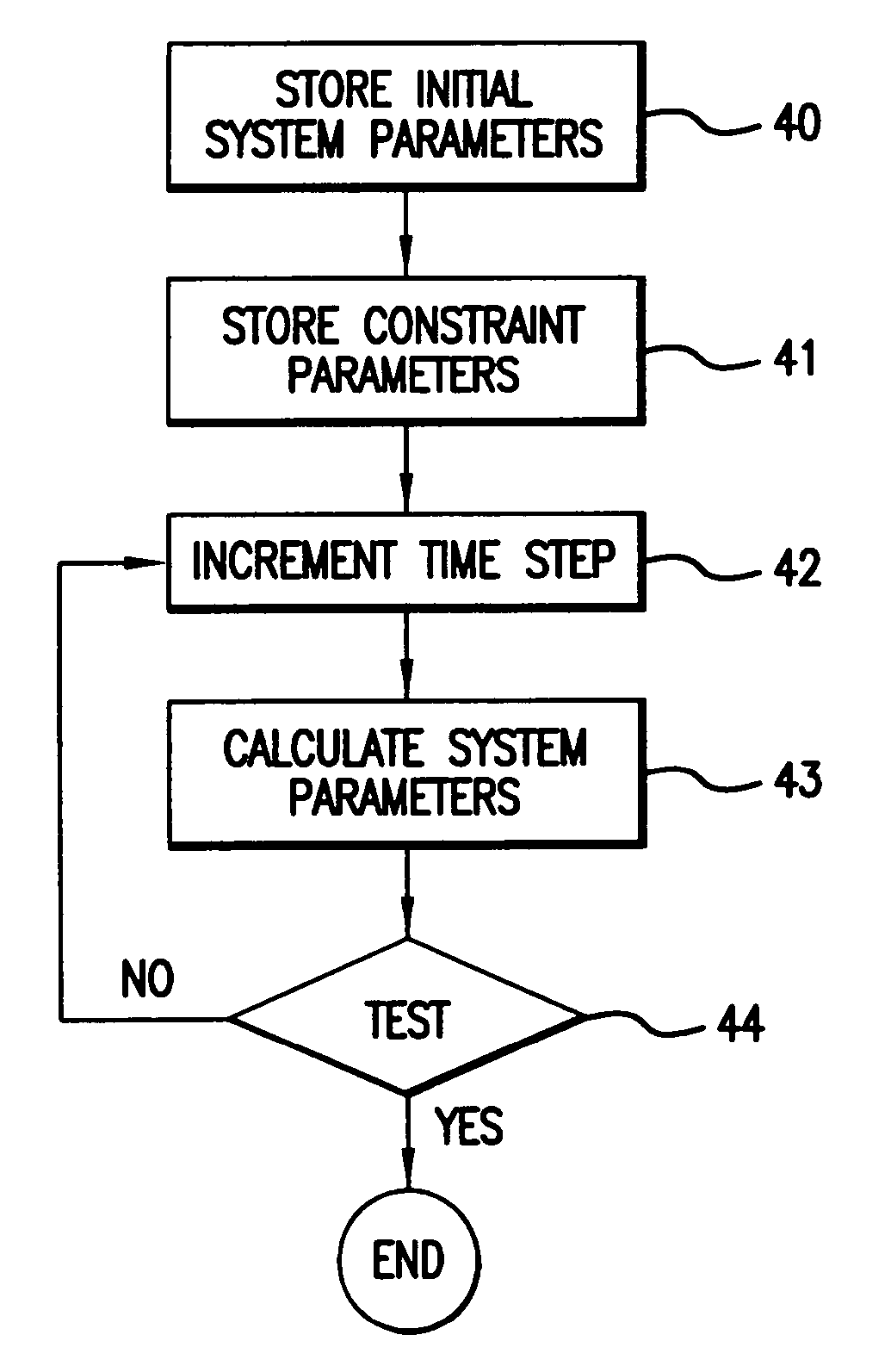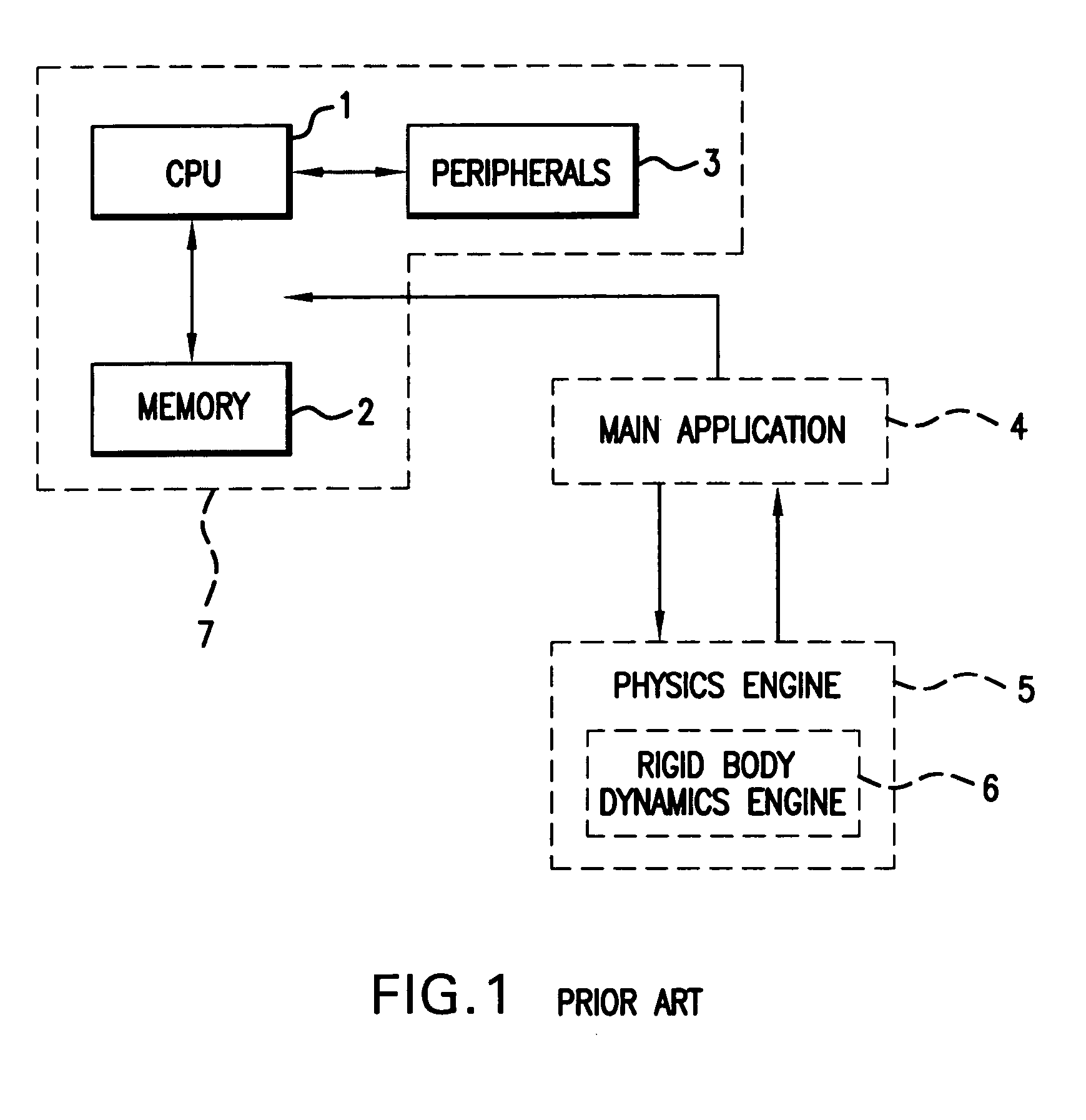Method and program solving LCPs for rigid body dynamics
a rigid body and program technology, applied in the field of method and program solving lcps for rigid body dynamics, can solve the problems of difficult practical development of physics-based animations, including rigid body simulations, and the loss of illusion of object rigidity, and achieve the effect of solving very small cases with algebraic solutions and reducing the difficulty of implementation
- Summary
- Abstract
- Description
- Claims
- Application Information
AI Technical Summary
Benefits of technology
Problems solved by technology
Method used
Image
Examples
example 1
PSEUDO CODE EXAMPLE 1
[0081]
f, x := 0, 0while x ≠ numIterationsi:=0while i ≠ mfi := max(0, fi − aii−1(bi + (Af)i))(9)i := i + 1endwhilex := x + 1endwhile
[0082]As can clearly be seen in equation (9) above, the projected iterative descent method is most computationally intense (or “dominated” by) the repeated multiplication of system matrix A by f. Thus, in so far as the this computational step can be simplified or reduced in iteration, the speed with which the LCP is resolved will be increased. Within the context of the present invention, the particular structure of system matrix A may be exploited by introducing an auxiliary variable which will significantly reduce the cost of the dominate computation noted above.
[0083]Although system matrix A is actually the mathematical product of three separate matrices, it is convenient to express A as the product of Jacobian, J, and the transpose of a “Jacobian / Mass” matrix JM, where JM is defined as the product of J and the mass-inertia matrix ...
code example 2
PSEUDO-CODE EXAMPLE 2
[0086]
f, v, x := 0, 0, 0while w ≠ numIterationsi := 0while i ≠ mfi := max(0, fi − aii−1(bi + (Jv)i))(12)v := (JM)T f(13)i := i + 1endwhilex := x + 1endwhile
[0087]The term (bi+(Jv)i) in the computational step above also has a physical interpretation, i.e. constraint space velocity for a current constraint row i, or more correctly the rate of change of the constraint violation for row constraint i. Considering that only one element of f changes per iteration, auxiliary variable v can be updated in an incremental way. This recognition allows the working Pseudo-Code example to be further optimized as shown below.
code example 3
PSEUDO-CODE EXAMPLE 3
[0088]
f, v, x := 0, 0, 0while x ≠ numIterationsi := 0while i ≠ mnewf := max(0, fi − aii−1(bi + (Jv)i))(14)v := v + (JM)iT(newf − fi)(15)fi := newfi := i + 1endwhilex := x + 1endwhile
[0089]As can be seen from (15) above, “newf” is an intermediate value that will be assigned back into the current candidate solution “fi”. The term “newf-fi” is thus used to incrementally update auxiliary variable v. Of note, equation (13) in Pseudo-Code example 2 requires the multiplication of a large matrix JM (size=6 n by m) with a large vector, candidate solution f (size=m). However, use of auxiliary variable v allows equation (15) in Pseudo-Code example 3 to replace this complex multiplication step with a small vector scaling and addition. Replacement of the complex, large-matrix by large vector multiplication step with a simple, scaled vector addition step, (newf−fi), greatly reduces the number of floating point operations required to compute each iteration.
[0090]The projected ...
PUM
 Login to View More
Login to View More Abstract
Description
Claims
Application Information
 Login to View More
Login to View More - R&D
- Intellectual Property
- Life Sciences
- Materials
- Tech Scout
- Unparalleled Data Quality
- Higher Quality Content
- 60% Fewer Hallucinations
Browse by: Latest US Patents, China's latest patents, Technical Efficacy Thesaurus, Application Domain, Technology Topic, Popular Technical Reports.
© 2025 PatSnap. All rights reserved.Legal|Privacy policy|Modern Slavery Act Transparency Statement|Sitemap|About US| Contact US: help@patsnap.com



